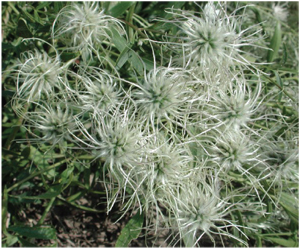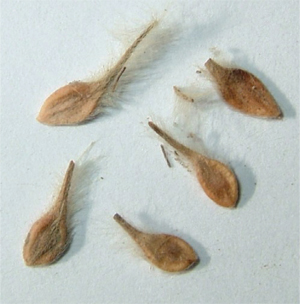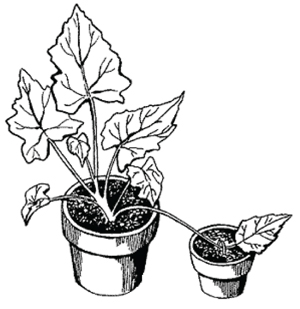G1861
Clematis
Any type of Clematis — vine, groundcover or shrub — will add summer-long color to a landscape. Learn how to select and care for this popular plant.
Dale T. Lindgren, Extension Horticulturist
Kim A. Todd, Extension Landscape Horticulture Specialist
Stephen N. Wegulo, Extension Plant Pathologist
Clematis is often called the “queen of the vines,” a designation which is well deserved. However, the genus Clematis includes more than just vines. Most gardeners are unfamiliar with the many non-climbing/non-clinging herbaceous types, sprawling groundcover forms, and shrubby types (Figures 1, 2, 3, and 4). There are even a few species native to the Great Plains.
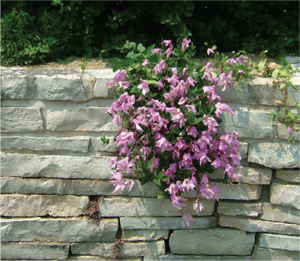 |
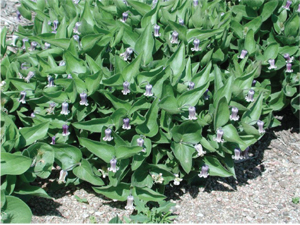 |
|
| Figure 1. Clematis integrifolia hanging over a wall (non-clinging). | Figure 2. C. fremontii as a border plant (shrub-type). | |
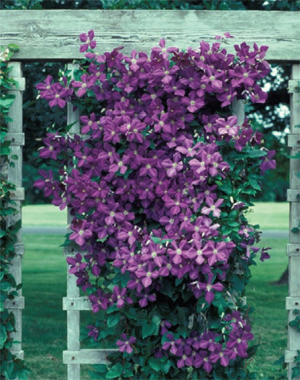 |
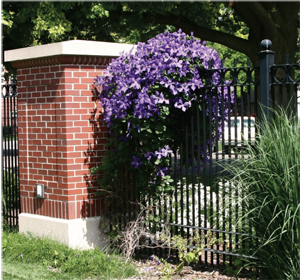 |
|
| Figure 3. Clematis on a trellis (vining type). | Figure 4. Clematis on a fence (vining type). |
The word clematis comes from the Greek word “klema,” meaning “a vine branch.” Clematis belongs to the buttercup (Ranunculaceae) family, which also includes peonies, anemones, and buttercups. There are over 290 named species of clematis and hundreds of cultivars. Some species and cultivars are available from many sources while others are very difficult to obtain.
In addition to the wide selection of species to choose from for growth habit, there is significant variation in flower shape, size and color, in seed head characteristics, season of flowering, and adaptation to local growing conditions. Leaf shape, form, and size also vary extensively.
Flowers vary from bell or urn-shaped to flat (Figures 5, 6, 7, 8, and 9). Flower colors include white, yellow, shades of pink, dark lavender, and red. Flower size ranges from less than one inch in diameter to more than 8 inches wide and vary in flower fragrance. The length and time of the blooming season varies with the individual species and cultivars.
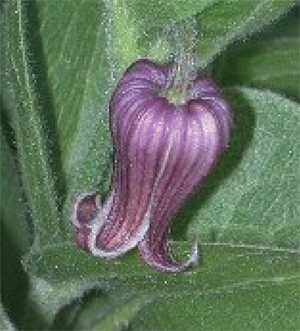 |
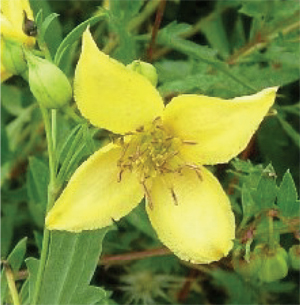 |
|
| Figure 5. C. fremontii flower. | Figure 6. C. fruticosa flower. | |
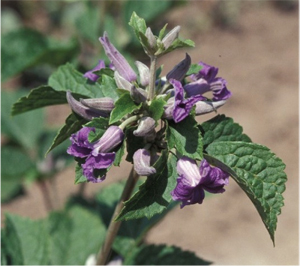 |
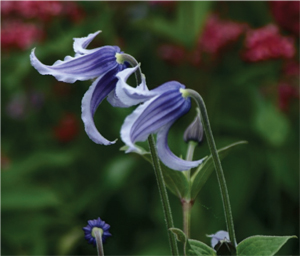 |
|
| Figure 7. C. heracleifolia flowers. | Figure 8. C. integrifolia flowers. |
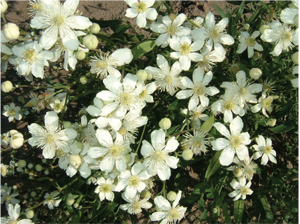 |
| Figure 9. C. hexapetala plant in flower. |
|
Vines can be as long as 30 feet or shorter than 2 feet. Some clematis are very drought tolerant while others require moist growing conditions. Clematis can be planted as companion plants with trees, shrubs, roses, perennials, and other clematis. Some selections can almost be invasive, depending on site conditions and space.
The fluffy achene seedheads of many clematis extend the season of interest. Seedheads of some species are persistent and remain on the plant through fall and early winter. Some last for only a short time (Figure 10).
Petals of clematis flowers are botanically called tepals. The flowers consist of these tepals with anthers and pistils (composed of stigmas and styles) in the center. The stigmas form the tails on the seeds. The seedhead is composed of many individual seeds.
Clematis can have simple or compound leaves. Vining clematis use the leaf petiole to cling, twisting it around a support much like a tendril on a grape vine. Clinging petioles is not a trait common to all clematis species.
The vining species and cultivars of clematis can be grown on a variety of supports, such as trellises, posts, trees, shrubs, walls, and mailboxes. Supports for clematis should be relatively thin because the twining petioles cannot grasp thick materials. Some training may be needed to direct vines in the desired direction. Vining clematis can also be used as groundcovers or to scramble down a wall or cover a stump. Intertwine them with climbing roses for an interesting look and extended season of bloom.
Selecting and Growing Clematis
The clematis species or cultivar selected should be determined by site conditions. As with all landscape plants, determine the available growing conditions and location; then select a plant that will be the right size and have the desired form or habit and aesthetic qualities.
The most common clematis cultivar in Midwestern gardens is ‘Jackmanii.’ This is an old, vining, purple cultivar, introduced in 1862. Several other popular, large-flowered, climbing cultivars include ‘Nelly Moser,’ ‘The President,’ ‘Barbara Jackman,’ ‘Niobe,’ and ‘Polish Spirit.’ There are several non-climbing or non-clinging species adapted to Great Plains growing conditions. These include C. fruticosa and C. fremontii, both promoted through the Nebraska Statewide Arboretum.
Some other shrubby type species that have performed well in Nebraska include C. heracleifolia (Figure 7), C. integrifolia (Figure 8), C. hexapetala (Figure 9), C. recta, and C. stans.
Planting is usually done in the spring. Select a site with at least six hours of sunlight, well-drained soil, and good air movement. Place the clematis plant about one inch deeper than it was grown in the container to help protect the crown; then mulch and water as needed. Transplanting is usually done in the spring, but if needed, plants can be moved in the early fall.
Plants should be fertilized during establishment using a balanced fertilizer. Once established, additional fertilizer is usually not needed except for sites that require special fertility treatments.
Mulching is useful not only to control weeds and conserve moisture, but to cool the soil. Clematis prefer ‘warm heads’ (tops) and ‘cool feet’ (roots). Often, other perennials are planted around the base of clematis to shade their roots and cool the underlying soil.
Most vining and clinging clematis plants prefer moist soil. However, many of the shrubby types are very drought tolerant, once established.
Growing clematis in containers can be challenging but rewarding. The growing medium should be high in organic matter. Select as large a container as possible. Supports or a trellis will be needed for most clematis in containers. Plants will also require some training. Containers may need to be insulated or moved to a sheltered location to successfully overwinter clematis. Some varieties suitable for containers include C. henryi, ‘Nelly Moser,’ ‘The President,’ ‘Polish Spirit,’ ‘Niobe,’ and ‘Sieboldii’ (Figure 11). ‘Sieboldii’ is an especially good variety for smaller containers.
Clematis can make excellent cut flowers, although the vining types can be more challenging as a cut flower because of their short stems. ‘Nelly Moser,’ ‘The President,’ and ‘Beauty of Worcester’ make good choices for vine types. Shrubby or herbaceous types for cut flowers include C. hexapetala (Figure 12), C. recta, C. heracleifolia, and C. integrifolia.
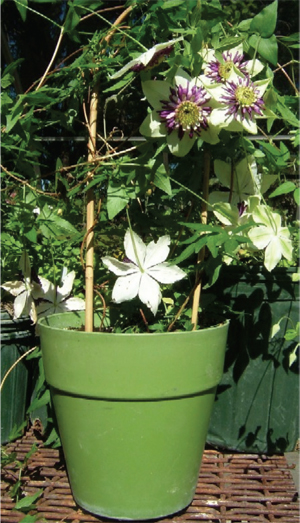 |
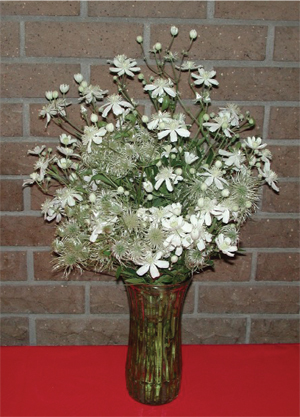 |
|
| Figure 11. Clematis ‘Sieboldii’ in a container. | Figure 12. Fresh bouquet of C. hexapetala. |
Pruning
Pruning can be one of the most confusing things about growing clematis. The main reasons for pruning are to establish a neat and tidy framework, to stimulate the development of buds and flowers, and to encourage growth. There are three general methods of pruning clematis and each is based on flowering time and whether or not the flowers are produced on stems from this year’s growth or on stems from previous years’ growth. Improper pruning is a common reason that gardeners are disappointed in the flowering of their clematis plant. Pruning groups for common species and cultivars are listed in Table I.
| Table I. List of species and cultivars for garden use. Many others are available. | |||||
| Species/Cultivar | Plant Habit |
Flower Color |
Pruning Group |
Plant Size Height x Width |
Flower Size (Inches) |
| C. ‘Barbara Jackman’ C.‘Ernest Markham’ C. fremontii C. fruticosa ‘Mongolian Gold’ |
Vine Vine Shrub Shrub |
Blue Red-violet Pink/lavender/white Yellow |
III II or III III III |
7’ x 2’ 9’ x 3’ 15” x 15” 3’ x 3’ |
4-6 5-6 3/4-1 1/2 1 |
| C.‘Guernsey Cream’ C. henryi C. heracleifolia* ‘China Purple’ C. hexapetala |
Vine Vine Shrub Shrub Shrub |
Creamy-yellow White/red anthers Purple to blue Purple White |
II II III III III |
8’ x 1 1/2’ 10’ x 4’ 4’ x 5’ 4’ x 4’ 3’ x 2’ |
4-6 5-7 1/2-1 1/2-1 1-1 1/2 |
| C. integrifolia
‘Alba’ ‘Durandii’ ‘Olgae’ ‘Rosea’ C.‘Jackmanii’ |
Non-clinging Non-clinging Non-clinging Shrub Shrub Vine |
Blue-lavender White Indigo blue Blue Rose Bluish-purple |
III III III III III III |
2’ x 1’ 2’ x 1’ 4’ x 1’ 2’ x 2’ 2’ x 2’ 12’ x 3’ |
1-2 1-2 3-4 1-1 1/2 1-1 1/2 4 |
| C.‘Nelly Moser’ C.‘Niobe’ C.‘Pamela Jackman’ C. pitcheri |
Vine Vine Vine Vine |
Rose/carmine stripe Velvety red Deep azure Dull purple |
II II or III I III |
8’ x 3’ 7’ x 3’ 8’ x 3’ 10’ x 3’ |
6-8 4-5 2 3/4-1 |
| C.‘Polish Spirit’ C.‘Ramona’ C. recta ‘Purpurea’ C.‘Royalty’ |
Vine Vine Shrub Vine |
Purple-blue Blue/lavender White Blue |
III II III II |
9’ x 4’ 9’ x 3’ 4’ x 2’ 6’ x 2’ |
3 5-7 3/4-1 4-6 |
| C. ternifolia (Sweet Autumn)* C. texensis C. ‘The President’ C. ‘Triternata Rubromarginata’ |
Vine Vine Vine Vine |
White Red Purple-blue White/pink tipped |
III III II III |
30’ x 10’ |
1/2-1 1-1 1/2 5-7 1-2 |
| C. viticella C. ‘Warsaw Nike’ C. ‘White Swan’ |
Vine Vine Vine |
Blue-violet Purple White |
III III I |
12’ x 2’ 10’ x 2’ 7’ x 2’ |
1-2 4-6 2 |
| *Fragrant | |||||
Pruning Group I: Species and cultivars in this pruning group flower on old, mature stems. Most are spring flowering. This group requires little or no pruning. However, they can be cut back and tidied up after the main flowering period has ended or if they have overgrown their space.
Pruning Group II: Species and cultivars in this group produce two flushes of flowers. The first occurs in spring on old, mature growth from the previous year, while the second flush occurs during late summer on the current year’s growth. Remove dead and damaged stems in late spring. If more pruning is necessary, do it immediately after the early flowering period. Shoots can also be pruned back to encourage re-blooming.
Pruning Group III: This group of plants is the easiest to prune. They usually flower on the current year’s new growth in spring to late summer. Annual pruning can be done in late winter or early spring, cutting back all the old stems to the base of the plant.
|
Propagation
Some species of clematis can be challenging to propagate, but starting plants from seed is easy to do for many of the species types, such as C. integrifolia (Figure 13). The germination of most clematis can be increased with a cold, moist seed stratification treatment. References on clematis seed germination can be found in libraries or on the Internet.
Division is the most practical method of propagating the clump-forming herbaceous and shrubby clematis, such as C. heracleifolia and C. hexapetala. Simply dig up the clump, divide it with a portion of the crown, buds and roots, and replant. Water well. This is best accomplished in early spring.
Some species start well from cuttings; others do not. The vining types, especially cultivars, are usually started from cuttings or layering. Cuttings should be taken from healthy semi-mature stems of the current year’s wood. Each cutting should have one pair of leaves. The lower end of the cutting can be treated with a rooting hormone and then placed in a medium such as perlite, peat, sand, or a mix of these. Cover the cuttings and containers with plastic to maintain high humidity, then place them in bright light but not direct sun. Once rooted, plants can be potted individually and later placed in the garden.
Many clematis can be propagated by layering (Figure 14). Select 1-year-old stems with good buds. Cut a 1-inch slit in the stem. Pin the stem to the soil in a container or on the ground with a wire. Cover the slit stem with soil and keep moist. Sever the stem when it has developed roots at the slit, gently dig up the rooted stem, and move it to the intended site.
Diseases and Other Pests
The most common disease affecting clematis is clematis wilt caused by the fungus Ascochyta clematidina. It is most prevalent on the large-flowered, vining types. Ascochyta clematidina infects clematis mainly through the lower nodes, especially if the stem has been damaged. The tissue around the node is destroyed and the damaged area turns black. The area above the node turns brown and dies, but the stem below the affected node remains green. Because the lesion extends across the entire stem, water and nutrient supply above the lesion is cut off and the stem wilts and collapses. One or more stems may be affected. Young plants are most susceptible. Remove the diseased stems by cutting across the green part of the stem at least 1 inch below the dead area. If the whole stem is affected, cut it just above the soil level. After removing the diseased stems, continue caring for the clematis as the roots often will send up new shoots. Sanitation will reduce the spread of clematis wilt. Remove all dead leaves and other plant debris in the fall to reduce the overwintering of diseases. This will lower the risk of clematis wilt the following spring.
Powdery mildew is occasionally a problem with clematis. Although it can be treated with fungicides, try to increase the air movement around the plant or move the plant to another location.
In general, insects are not a problem in the Great Plains. Aphids can feed on the foliage and slugs may feed on succulent, new growth.
Damage by other pests, such as slugs, rabbits, mice, birds, gophers, and deer is usually minor. Protect newly planted clematis with wire cages tall enough to prevent rabbit feeding, if necessary, until plants are vigorous enough to outgrow the damage.
Clematis can be a wonderful addition to the home landscape. Consider enhancing your landscape with one or more of the many types of clematis.
This publication has been peer reviewed.
Visit the University of Nebraska–Lincoln Extension Publications Web site for more publications.
Index: Lawn & Garden
Ornamentals
Issued June 2008
